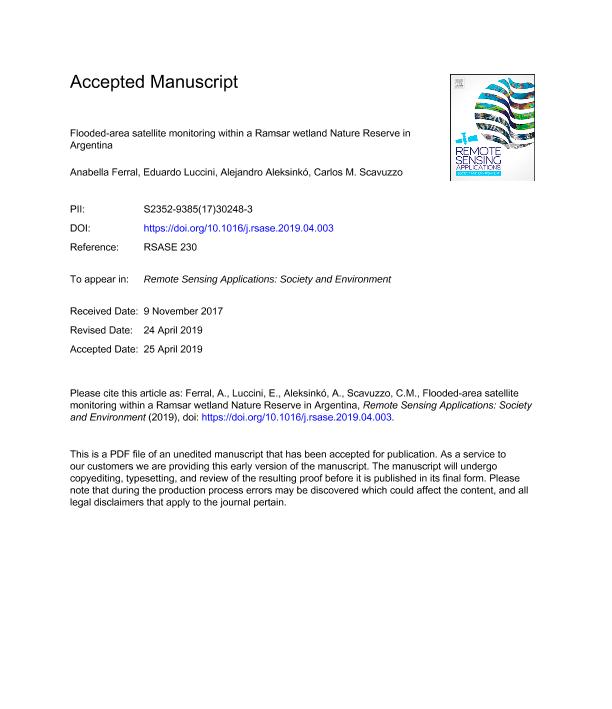Mostrar el registro sencillo del ítem
dc.contributor.author
Ferral, Anabella

dc.contributor.author
Luccini, Eduardo Alfredo

dc.contributor.author
Aleksinkó, Alejandro
dc.contributor.author
Scavuzzo, Carlos Matias

dc.date.available
2021-03-10T21:25:26Z
dc.date.issued
2019-08
dc.identifier.citation
Ferral, Anabella; Luccini, Eduardo Alfredo; Aleksinkó, Alejandro; Scavuzzo, Carlos Matias; Flooded-area satellite monitoring within a Ramsar wetland Nature Reserve in Argentina; Elsevier B.V.; Remote Sensing Applications: Society and Environment; 15; 100230; 8-2019
dc.identifier.uri
http://hdl.handle.net/11336/128029
dc.description.abstract
The protection and restoration of water-related ecosystems is one of the goals to be achieved by the United Nations’ 2030 Agenda for Sustainable Development. In this framework and requested by government Argentine institutions concerned with water, biodiversity and territorial management, this study analyzes the evolution of the flooded area within the Dulce River wetlands and Mar Chiquita Lake Nature Reserve (centered around 30.6°S, 62.6°W, 70 m above sea level) in Argentina since 2003, when the historical maximum extent was reached, until 2017. The Modified Normalized Difference Water Index (MNDWI) was calculated on atmospherically corrected NASA Landsat 5 Thematic Mapper (L5-TM) and Landsat 8 Operational Land Imager (L8-OLI) reflectance data over two-scene cloudless-sky mosaics to cover the whole Reserve. Mixed-water pixels constituted an important fraction of the total-water covered area, particularly during years of minimum water level in Mar Chiquita Lake. So, MNDWI values were analyzed along transects crossing two stable regional water bodies to determine precise thresholds for detection of non-water (MNDWI < −0.15 for L5-TM, MNDWI < −0.35 for L8-OLI), mixed-water (−0.15 < MNDWI < 0.4 for L5-TM, −0.35 < MNDWI < 0.5 for L8-OLI) and open-water (0.4 < MNDWI for L5-TM, 0.5 < MNDWI for L8-OLI) pixels. A higher spatial resolution image, SPOT5-HGR2, was used to validate the classification method. A confusion matrix was built which resulted in an overall accuracy of 99.2% and a Kappa coefficient of 0.98. In-situ Geo-referenced photographic registers were also taken simultaneously to a Landsat 8 overpass to confirm the classification thresholds. The analysis of simulated MNDWI response, by using the assumption of the linear mixture model, showed that mixed pixels should present from 9% to 76% of detectable open-water area. Maximum total flooded area extensions of about 3600 km 2 by 2003–2005 and a minimum one of 2050 km 2 by the end of 2011 were established, followed by a recent trend to the recovering with a total flooded area of about 3400 km 2 in the period 2015–2017. Open-water covered area follows closely the behavior of in-situ water level measurements of Mar Chiquita Lake, showing a maximum in year 2003 and a minimum towards the end of 2013, in a significant linear relation from which a topographical slope of the terrain of about 0.012% is inferred that agrees with previous bathymetric studies. Results show the powerful complement between a reliable water satellite monitoring tool and locally-measured parameters in so dynamic wetland regions.
dc.format
application/pdf
dc.language.iso
eng
dc.publisher
Elsevier B.V.
dc.rights
info:eu-repo/semantics/openAccess
dc.rights.uri
https://creativecommons.org/licenses/by-nc-sa/2.5/ar/
dc.subject
LANDSAT
dc.subject
MIXED WATER
dc.subject
MNDWI
dc.subject
WETLAND
dc.subject.classification
Oceanografía, Hidrología, Recursos Hídricos

dc.subject.classification
Ciencias de la Tierra y relacionadas con el Medio Ambiente

dc.subject.classification
CIENCIAS NATURALES Y EXACTAS

dc.title
Flooded-area satellite monitoring within a Ramsar wetland Nature Reserve in Argentina
dc.type
info:eu-repo/semantics/article
dc.type
info:ar-repo/semantics/artículo
dc.type
info:eu-repo/semantics/publishedVersion
dc.date.updated
2021-03-05T18:51:09Z
dc.identifier.eissn
2352-9385
dc.journal.volume
15
dc.journal.number
100230
dc.journal.pais
Países Bajos

dc.journal.ciudad
Amsterdam
dc.description.fil
Fil: Ferral, Anabella. Universidad Blas Pascal; Argentina. Comision Nacional de Actividades Espaciales. Instituto de Altos Estudios Espaciales "Mario Gulich"; Argentina. Consejo Nacional de Investigaciones Científicas y Técnicas; Argentina
dc.description.fil
Fil: Luccini, Eduardo Alfredo. Provincia de Córdoba. Ministerio de Ciencia y Técnica. Centro de Excelencia en Productos y Procesos de Córdoba; Argentina. Consejo Nacional de Investigaciones Científicas y Técnicas; Argentina
dc.description.fil
Fil: Aleksinkó, Alejandro. Secretaría de Recursos Hídricos y Coordinación de la Provincia de Córdoba; Argentina
dc.description.fil
Fil: Scavuzzo, Carlos Matias. Comision Nacional de Actividades Espaciales. Instituto de Altos Estudios Espaciales "Mario Gulich"; Argentina. Consejo Nacional de Investigaciones Científicas y Técnicas; Argentina
dc.journal.title
Remote Sensing Applications: Society and Environment
dc.relation.alternativeid
info:eu-repo/semantics/altIdentifier/url/https://www.sciencedirect.com/science/article/abs/pii/S2352938517302483
dc.relation.alternativeid
info:eu-repo/semantics/altIdentifier/doi/https://doi.org/10.1016/j.rsase.2019.04.003
Archivos asociados
